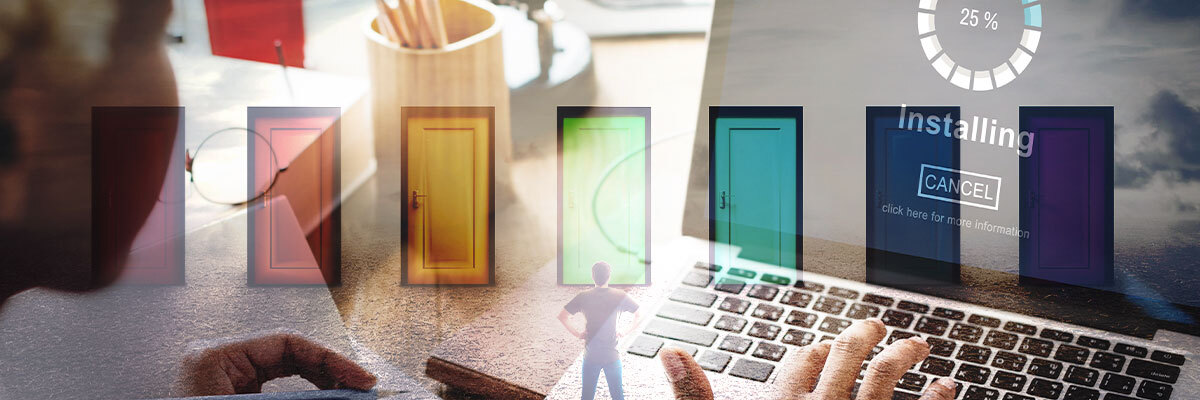Webinar Tips: Your Ultimate Guide To Hosting A Great Event
A great way for agencies and small enterprises to position themselves as thought leaders and to cast events to national and potentially global audiences at a lower cost is to host a webinar.
In fact, adoption of webinar platforms has soared during the pandemic as companies scramble to virtually deliver roadshows and in-person events. According to the latest ON24 Webinar Benchmarks Report, webinars in 2020 increased 162 percent and attendance nearly quadrupled to more than 60 million people. Audiences engaged with 61 million hours of content, which represents growth of nearly 300 percent
This guide provides a comprehensive outline on the pros and cons of webinars, some of the best webinar platforms to use, and tips on how to host an engaging event.
Table Of Contents
- The benefits and downsides of webinars
- Tip #1 - Find an interesting topic
- Tip #2 - Research and trial the best platforms
- Tip #3 - Find passionate presenters
- Tip #4 - Schedule it at a convenient time for attendees
- Tip #5 - Plan and rehearse before the big day
- Tip #6 - Promote it well ahead of time
- Tip #7 - Execute the discussion but be flexible
- Tip #8 - Send a replay and follow-up leads
- Conclusion
The benefits and downsides of webinars
Even though hosting webinars online doesn’t provide the opportunity to clink glasses with customers and prospects face-to-face, it can help your agency attract prospects and build great relationships. Below are six proven reasons why you should incorporate webinars into your marketing strategy.
Pros:
- Webinar attendees are generally leads. Between 20 percent to 40 percent of external webinar attendees become qualified leads.
- Webinars drive sales. In addition to lead generation metrics, up to 5 percent of webinar attendees become paying clients.
- Webinars are engaging. According to MakeSocialMediaSell, webinars retain the attention of 40 percent of viewers.
- Webinars build authority. If your company has enough information to host a one-hour webinar on any topic, then you are probably an authority in your industry, and the webinar will help you reaffirm that.
- Webinars can accelerate sales cycles. Prospects in the middle of a purchase decision might be pushed faster through a sales funnel with an informative and educational webinar.
- Webinars are relatively low cost. It’s a presentation without the need for an auditorium or boardroom.
While the lead-generation and conversion opportunities seem attractive, it’s important to note that webinars should first and foremost be viewed as an educational or thought leadership exercise. Webinars that are pure product flogs are a dealbreaker for attendees according to Ashley Stahl, founder of branding agency CAKE Publishing.
“One of the biggest mistakes I see clients making is focusing too heavily on the end sale and not enough on content,” she wrote in a Forbes article.
Most registrants who attend webinars do so because the topic piqued their interest. They use these events to gauge your expertise and build trust in your brand before deciding whether to buy from you. A pure sales pitch during a webinar may discourage prospects from wanting to engage with you.
For example, your agency may specialize in search engine optimization or SEO. Framing a webinar topic and the overarching discussion around “SEO strategies for small businesses” is likely of more interest to a prospect than “Why you should pay us to be your SEO agency.” Prospects become ‘warm leads’ and are much more likely to contact you or be open to outreach if they gain actionable insights from your webinar content.
Choice of topic and how your webinar is structured aside, there are a few factors that could negatively impact an event.
Cons:
- Attendance drop off. Unless you’re charging a fee to webinar attendees, there’s little incentive for guaranteed attendance. In fact, it’s estimated that only half of those who register for webinars actually attend. Most companies are hosting webinars for free as there is little incentive from a customer’s point of view to pay for them given they lack the glitz, glamour, and fancy catering typically associated with in-person events. The cost of a webinar service is offset through lead generation opportunities and the ability to deliver the event to a wide audience.
- Technical issues. Virtual sessions always run the risk of technology failure.
- Interaction and distractions. The engagement of an in-person event cannot be easily replicated online. Virtual presentations are more passive and less dynamic than buzzing auditoriums full of people. Live presentations often create opportunities for greater audience interaction as well. Without the same level of stimulation, virtual sessions are bound to be prone to distractions.
To be fair, these same risks can exist in live events and might be mitigated through webinar tips outlined in the next section.
How to create an amazing event
Webinar Tip #1 - Find an interesting topic
Step one is the topic of your webinar. In selecting a topic, you want to identify something that attendees seek to learn more about and map it back to your product or service. Stahl recommends saving the sales plug to the end, after you’ve provided value and education to attendees.
“Do not talk about your product until the very end of your presentation. Sell it too early and your audience will likely get those icky sales vibes we all dislike. That said, there’s nothing wrong with mentioning the name of your product a couple of times in passing as you present. Provide great content upfront. Sell at the very end,” she says. A timely topic may amplify interest, particularly if it addresses something urgent that requires immediate attention or is tactical and prescriptive.
Other considerations include:
- Offering some type of promotion or freebie to attendees
- Consider multiple webinars if it is an important topic that requires discussion beyond an hour

Webinar Tip #2 - Research and trial the best platforms
As someone who has hosted hundreds of webinars over the past 10 years, Hailey Friedman, Co-Founder of Growth Marketing Pro, knows how to spot red flags when selecting a webinar platform provider.
“Run the other way if you see a webinar tool that involves confusing downloads and extensions, poor customer service, technical difficulties with sound and video, and overcomplicated dashboards. It’s simply not worth the headache of dealing with these issues. You and your attendees deserve better,” she says.
When considering a platform, Friedman suggests looking at a few important factors:
- Do viewers need to download a plugin?
- How many attendees are allowed in the room?
- Does the platform support multiple presenters?
- Does it send out email reminders to registrants?
- Is the webinar software for live webinars, on-demand webinars, or both?
- Are there any other helpful features like live chat and polls that the audience can engage in?
Friedman has test-driven 23 of the best known webinar platforms. The key takeaways from her research are provided below.
Demio - The best overall webinar platform
Demio markets itself as a simple, no-download webinar experience for your audience that lets hosts apply their branding and logo across event materials.
“This tool is great for beginners and for those who feel uncomfortable with the clunky interfaces and numerous settings associated with some webinar platforms. On the other hand, professional marketers and busy corporate users will appreciate its extensive automation tools,” Friedman says.
Pros:
- Fully browser-based (no software to download)
- Live and automated on-demand webinars
- Takes minutes to set up
- Modern and customizable: you can add your logo so it matches your brand
- Automated reminder emails for scheduled events
- Ability to send the webinar recording to all registrants after the event
Cons:
- Hosting more than 50 live participants requires an upgrade
Demio Pricing:
- Two-week free trial
- Starter Plan: US$34/month for a 50-person attendee room
- Growth Plan: US$69/month for a 150-person attendee room and customized branding
- Business Plan: US$163/month for a 500-person attendee room and four hosts
Google Hangouts - The best free webinar platform
Hangouts is free Google software that works with YouTube. It’s designed for small groups of up to 30 people. To hold a webinar on Google Hangouts, you need your own channel on YouTube and the Chrome browser installed.
“Google+ Hangouts is very popular in the corporate world because it allows handy features for inviting the members. Moreover, several people can speak during one event, and the webinar can be easily shared upon completion,” Friedman says.
Pros:
- Can host 30 people for free
- Webinar is automatically recorded and uploaded to your YouTube channel
- It is possible to broadcast the webinar through YouTube to accommodate a larger audience
Cons:
- Attendees need a Google account to take active part in the event (for example, having the ability to ask questions)
- Difficult to capture leads as there is no functionality that lets attendees register their details to access the event
Hangout Pricing:
- Completely free
What about Zoom?
While Zoom has become a household name during the pandemic, it didn’t stand out as a top choice for Frediman, ranking #10 on her list.
“Zoom’s limitation is that, while it offers basic features for free, your meetings can continue for less than 40 minutes if the number of attendees is less than 100. That’s because Zoom is built for large companies who are going to fork over big dollars for video conferencing technology,” she says.
Pros:
- Simultaneous screen share for several attendees
- Free desktop and application sharing
- Works on all platforms and devices
- Records the complete event, including the questions asked by attendees via chat and the videos from multiple speakers
Cons:
- Interface navigation can be confusing
- Zoom hardware simply doesn’t work well
Zoom Pricing:
- Free webinars for up to 100 participants with a maximum 40-minute duration
- Paid plans start from US$14.99 per month and include unlimited meeting duration with up to 100 participants.
Webinar Tip #3 - Find passionate presenters
The beautiful thing about hosting webinars, compared to presenting at an in-person event, is that virtual events are usually a lot more casual. That’s not to say that you don’t need to keep attendee interest, but you also don’t need to be a world-class formal presenter to deliver a great session. You can even get away with using scripts and other information resources to assist you.
A presenter should be:
- A subject matter and/or product expert
- A competent speaker
- Genuinely interested in doing it
It’s also best practice to have an energetic and personable host or moderator. This type of person can open the event, welcome speakers, manage and ask questions on behalf of participants, and ensure that the audience remains engaged so that subject matter expert(s) can focus primarily on their presentation without distraction.
Webinar Tip #4 - Schedule it at a convenient time for attendees
When you book a date for your webinar, there are important considerations to consider in order to drive optimal attendance:
- Day of the week. Mondays and Fridays should be avoided as most people are either ramping up or winding down during these days.
- Time of day. Mornings are generally much more hectic for business people, so 1 pm to 3 pm Eastern Time is generally considered the best window for booking a webinar in North America.
Webinar Tip #5 - Plan and rehearse before the big day
There are a few items you will want to keep in mind when planning how to do a webinar:
- Think about where to host a webinar. Factors to consider include finding a quiet space with good lighting and a tidy, distraction-free backdrop for viewers. If it’s difficult to find a visually appealing area, you may wish to use a virtual background if your webinar platform offers this.
- Most webinars are an hour - 45 minutes for presentation and 15 minutes for questions. However, 30-minute events (20 for presentation and 10 for questions) are becoming increasingly popular. Be open to mixing approaches and formats to determine what works best for your audience.
- Speaking to each slide for one to two minutes is a good rule of thumb when constructing your presentation.
- Reiterate the most important points. Tell them once, tell them again, and tell them a third time.
- Your format should be: introduce the value, provide a deep topic exploration, introduce your product with a soft sell, and then recap.
- Speak to your customers, not above them. Your language should be simple and easy to understand.
- Anticipate questions and prepare frequently asked questions (FAQs) based on your topic. If the webinar is product-based, keep a list of questions about your product that customers have asked.
Cory Northcutt, CEO of Northcutt Enterprise SEO, says the best webinars are dynamic and involve the audience. He suggests: “Don’t read from a script or your slides; use an outline. And speak spontaneously. Invite questions and answer them. Make time for questions during the webinar, not just at the end. Make your slides visually appealing and informative; long lists of bullet points are not interesting. Most importantly: use a decent microphone.”
Once you’ve gone through this list, created your slides, scheduled your webinar, practiced it, and wrangled up attendees, you should be ready to deliver.

Webinar Tip #6 - Promote it well ahead of time
Below are things to consider in marketing your webinar.
The mandatory stuff:
- A registration landing page
- Organic social media posts to promote the session
- Email marketing to invite known prospects to register
- Allow registrants to pre-submit questions
A key tip from Stahl is to market your webinar weeks in advance. “Don’t start advertising the day before. I recommend starting to advertise at least a month in advance, if not more. You’ll want to send reminders as the event gets closer, including an email reminder the day before and day of. I also recommend doing a countdown on your social media,” she says.
Optional promotional activities to consider include:
- Paid ads to target prospects and other external markets
- Customer-wide emails to advertise the webinar
- Engaging sponsors as a marketing tactic for big sessions
- Creating a promotional video
- Promotional pop ups on your website
- Follow-up emails to collect feedback and engage attendees
Webinar Tip #7 - Execute the discussion but be flexible
Now it’s time to present your content. Consider doing the following:
- Send a last-minute reminder email one or two hours prior to the start of your webinar.
- Be flexible as certain audience questions might shift the direction of the conversation. Control it by choosing which questions to answer live. If the topic is specific, those questions are generally the best ones to take offline.
- Speak slowly and confidently so that the audience easily understands you.
- Use your mouse to highlight items on the slides that you want the audience to see.
- Ensure you are presenting in a distraction-free environment.

Webinar Tip #8 - Send a replay and follow-up leads
If you aren’t reproducing your webinar content and conducting webinar follow-ups, then you may be missing out on marketing opportunities that can be gathered from content that’s already been created.
Here are post promotion ideas for your webinar:
- Send out a recording of the session and slide deck. Not all who register will actually attend the webinar, so sending a follow-up email that includes the content is a great way to engage leads that might not have made it to the live session.
- Post the webinar video online. Posting your webinar on a branded YouTube channel is a great way to gain additional traction and rank for topical results on YouTube searches.
- Use slides to create sales decks. If your webinar is product focussed, consider converting some of your content into sales collateral.
- Ask for feedback. A short attendee survey is a great way to get insights into what parts of the webinar the audience enjoyed most, and where there might be room for improvements.
Conclusion
With technological adoption pulled forward due to COVID, online webinars will likely remain popular. Many companies now realize they can deliver engaging events at a fraction of the cost of in-person sessions.
In fact, ON24’s Daheb says nearly all marketers cite hosting webinars as a key part of their strategies even in a post-pandemic era. “Digital engagement is enabling marketing and sales teams to reach more people and spend more time with their prospects and customers,” he says.
While it takes time and effort to set up your webinar strategy, the payoff is that once you’ve hosted one webinar, subsequent events become easy to replicate. And the benefits in terms of brand trust, sales leads, and audience insights keep growing.

